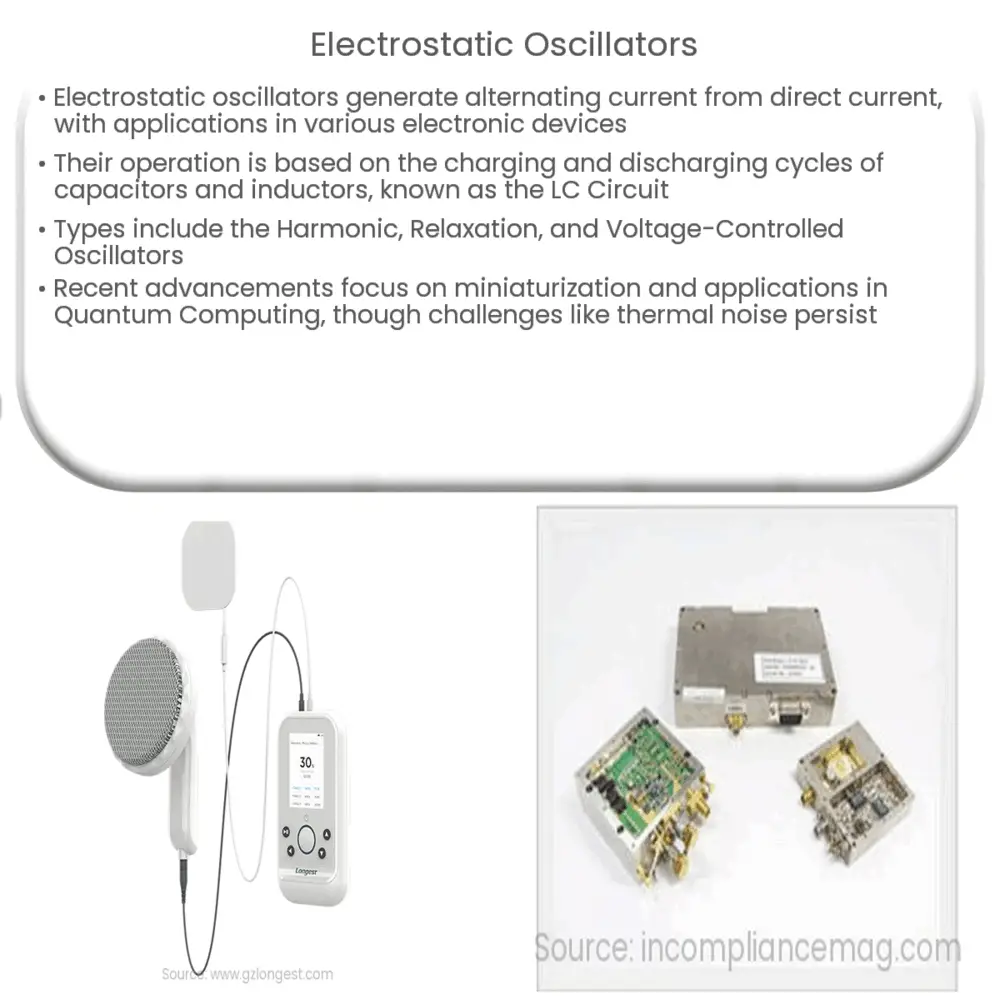Explore the world of Electrostatic Oscillators: their operation principles, types, applications, recent advancements, and future potential.

Introduction to Electrostatic Oscillators
An Electrostatic Oscillator is an electronic device that generates an alternating current (AC) output from a direct current (DC) power source. In essence, it oscillates between electrical charges, hence the name. The oscillator’s operating principle is primarily based on the interaction of electrical charges and the law of conservation of energy. Electrostatic oscillators have a variety of applications, ranging from radio and television transmitters to quartz clock oscillators.
Principle of Operation
At the core of every electrostatic oscillator is a capacitor and an inductor. When a direct current (DC) is applied, the capacitor begins to charge. Upon reaching its maximum charge capacity, the stored energy is released into the circuit, causing the electrical current to flow in the opposite direction. This causes the inductor to discharge, setting off a cyclical pattern of charging and discharging. The rate of oscillation is determined by the time it takes to fully charge and discharge the capacitor and inductor. This operation principle is commonly known as the LC Circuit or LC Oscillator.
Types of Electrostatic Oscillators
- Harmonic Oscillator: This type of oscillator operates on the principle of harmonic motion, where the frequency of the output waveform is a harmonic multiple of the input frequency. It is most commonly used in audio and RF applications.
- Relaxation Oscillator: Relaxation oscillators, on the other hand, generate non-sinusoidal waveforms, such as square or triangular waves. They achieve this through a process known as “relaxation”, where the capacitor charges and discharges at irregular intervals.
- Voltage-Controlled Oscillator (VCO): A VCO is an oscillator whose output frequency is controlled by a voltage input. This type of oscillator is widely used in synthesizers, phase-locked loops (PLLs), and frequency modulated (FM) radios.
Applications
The capabilities of electrostatic oscillators make them integral in various fields and applications. They are crucial in telecommunication systems for generating carrier signals. In addition, they are used in musical instruments, computers, clocks, and many other electronic devices. For instance, quartz clock oscillators employ the principles of electrostatic oscillators to maintain accurate time. In the next section, we will further explore the uses and recent developments of these devices.
Recent Developments and Innovations
With technological advancements, electrostatic oscillators have evolved and improved significantly. For instance, there have been strides in the development of miniature electrostatic oscillators for use in micro-electro-mechanical systems (MEMS) and nano-electro-mechanical systems (NEMS). These advancements have enabled the creation of highly compact and efficient electronic devices.
Furthermore, the rise of Quantum Computing has led to a new generation of electrostatic oscillators designed to operate at cryogenic temperatures. These oscillators are specifically designed to meet the stringent requirements of quantum systems, thereby playing a crucial role in the future of computing.
Challenges and Future Directions
Despite the significant strides in the development of electrostatic oscillators, challenges still exist. One of the key challenges is thermal noise, which can affect the oscillator’s performance and stability. Researchers are constantly developing techniques to minimize this issue and improve the reliability of these devices.
In terms of future directions, there’s an increasing interest in developing more energy-efficient oscillators for portable devices. Moreover, as the field of Quantum Computing continues to evolve, the demand for more advanced and specialized electrostatic oscillators will undoubtedly increase.
Conclusion
Electrostatic oscillators are pivotal in the operation of many electronic devices. Their role in transforming direct current into alternating current allows for the facilitation of various communication systems and the operation of everyday devices. As technology advances, these oscillators continue to evolve, with a future brimming with promising opportunities for improved efficiency, miniaturization, and specialized applications. Despite the challenges faced, continued research and innovation will undoubtedly lead to the development of more sophisticated and reliable electrostatic oscillators, heralding exciting advancements in electronics and technology as a whole.



